






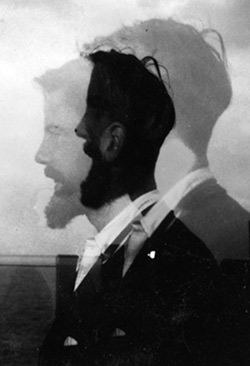 Lieutenant Tony Sangster RN, the Gunnery and Correspondence
Officer on HMS Venomous, wrote a 180 page unpublished memoir of his service in the
Royal Navy. He joined Venomous in March 1942 after its refit following the collision with HMS Keppel and his memoir includes a description of convoy PQ.15 to Murmansk in northern Russia, the sinking of HMS Eagle
while escorting a convoy to relieve the besieged island of Malta and
the events of the night of the 11 - 12 November 1942 when Hecla sank.
Lieutenant Tony Sangster RN, the Gunnery and Correspondence
Officer on HMS Venomous, wrote a 180 page unpublished memoir of his service in the
Royal Navy. He joined Venomous in March 1942 after its refit following the collision with HMS Keppel and his memoir includes a description of convoy PQ.15 to Murmansk in northern Russia, the sinking of HMS Eagle
while escorting a convoy to relieve the besieged island of Malta and
the events of the night of the 11 - 12 November 1942 when Hecla sank.
Tony
Sangster was born in Kandy, the ancient capital of Ceylon, in 1921
where his father was a tea planter. He was sent to prep school,
Stubbington House School ("the cradle of the Navy") in Fareham,
Hampshire, as a child of seven and farmed out to relatives during the
school holidays. His older brother, known as Derek Sangster
(but christened Anthony Trevor), had chosen the Navy as his career and
Tony Sangster followed him. They were both Cadet Captains at the Royal Navy College,
Dartmouth, served throughout the war and retired as Lieutenant Commanders in the 1950s.
Tony Sangster went to Dartmouth in 1934 and on leaving in 1938 joined the cruiser, HMS Vindictive, for his sea training. When war was declared he was serving as a Midshipman on the battleship, HMS Warspite. After a promotion course at HMS Victory, Portsmouth, and further training he was posted to the cruiser, HMS York, at Singapore.
On the 11 March 1941 he embarked at Liverpool on the SS Britannia, a passenger liner adapted for use as a troop carrier, bound for Bombay via Freetown and Durban. The Britannia was attacked and sunk by the German commerce raider Thor near the Cape Verde Islands on the 24 March and the passengers and crew took to the lifeboats. Tony Sangster's lifeboat was waterlogged with only the stem and stern above water. There were only nine survivors out of the fifty four in his lifeboat when they were picked up after five days by the neutral Spanish ship, Cabo de Hornos. They were landed at Tenerife in the Canary Islands where the British Consul negotiated with the Captain General of Canarias that they would be treated as "Distressed British Seamen" and confined in a hotel at Santa Cruz which constituted an "internment camp". They were under parole and accountable to the Consul and their Senior Naval Officer. After four months the Consul was able to arrange for them to be released at Gibraltar and he was posted to the destroyer HMS Montrose as Sub Lt Navy Signals in September 1941.
He made an interesting comparison between Montrose and Venomous which is worth quoting here:
"Venomous was an extraordinary ship. She behaved very well in rough weather, and was quite unlike Montrose which being 30 feet longer was really beautiful with two matched funnels. However, 'andsome is as 'andsome does, because although Montrose with her beautifully flared bow and her balanced silhouette looked so nice she was an absolute pig at sea. She had so much top weight that she heeled crazily under large rudder, and rolled all over the place. Worse still, when she pitched, her after end used to whip up and down and you could not keep your feet on the deck. You really had the impression of being on a diving spring board."
He was plagued with persistent inner ear and throat infections, the lingering after effects of his time in the lifeboat, and was eventually invalided out of Montrose. He joined HMS Venomous
in time for Arctic Convoy PQ.15 to Murmansk in Northern Russia which is
described in his unpublished memoir. This was followed by escorting
Convoy WS.21S to relieve the besieged island of Malta when HMS Eagle was sunk and Venomous took several hundred survivors back to Gib., a low key "rehearsal" for the dramatic events of the 11 - 12 November 1942.
Tony Sangster's account of what happened when Hecla was torpedoed begins as Convoy KX.4A assembled off Gourack at the mouth of the Clyde.
 Venomous
left Gourack after fond farewells to “Two Ton Tess” [probably the
"torpedo" with the one ton depth charge fitted in the No. 1 torpedo tube during
the refit at Troon; also known as the 'brute', it was never used], and
a very special
Patricia, in the Bay Hotel the previous night. Usual convoy we
supposed, but no, off the Mull of Kintyre where all the elements of the
convoy assembled, there were passenger ships, fast liners with troops
crowding them.
Venomous
left Gourack after fond farewells to “Two Ton Tess” [probably the
"torpedo" with the one ton depth charge fitted in the No. 1 torpedo tube during
the refit at Troon; also known as the 'brute', it was never used], and
a very special
Patricia, in the Bay Hotel the previous night. Usual convoy we
supposed, but no, off the Mull of Kintyre where all the elements of the
convoy assembled, there were passenger ships, fast liners with troops
crowding them.
The Captain, Commander Falcon-Steward, was I think Senior Officer of
the Escort and there was the usual extended climax of signaling by
lamp and flag to the Commodore, and the escorts to arrange ourselves in
the appropriate pattern. After all the usual grind of protecting trade,
at last it looked as if we were going on the offensive!
The general direction of advance was west south-west, way, way out into
the Atlantic. October 1942 – were we going to attack the West Indies or
South America? At last we turned South, and later on South East for
good historic approaches to the Mediterranean where Nelson had taught
the world a lesson which still stirs my heart today in 1981.
They had a Royal Fleet Auxiliary tanker in the convoy from which all
the escorts fueled in turn in the last stage before the Straits of
Gibraltar.
At dead of night the great ships passed through these straits, and more
escorts joined, and Venomous was detached to steam in the reverse
direction westwards. Meanwhile, the great merchant ships, the real
might of Great Britain, went eastward into the Med., with those brown
job soldiery on board. They were the second wave of Torch, the code name for the North African landings.
Convoy Escorts for HMS Hecla and HMS Vindictive
The next day found us with Marne,
one of the really chunky destroyers of L&M Classes in line abreast
making SW out of sight of the African coast at 15 knots. Security was
so strict that even the officers of the Watch knew not what to expect.
Two days out of the Straits:
“Captain, Sir!”
“Yes, ”
“Two ships on the horizon at Red one oh, mast only in sight.”
Marne’s ten-inch signal lamp proved that they were equally alert and aware of the sightings.
And so in half an hour we met our convoy: Vindictive (my cadet training cruiser four years ago, but now converted into a submarine depot ship) and Hecla, sister ship of Tyne, built as a destroyer depot ship. Maximum speed of convoy 15 knots, albeit Vindictive could do 24.
Venomous took the starboard wing position, and Marne
the port wing and, we turned back towards the Straits of Gib., or in
naval parlance – “the gut”. Conventional zig-zag, escort conforming.
The Asdic Operator reports a contact ...
I had the first watch that night (2000-2400) and about 2315 the Asdic
sonar operator [George Wilson,
the 19 year old Asdic operator, who reported to Warrant Officer
"Jimmy" Button, the Anti-submarine, Bo'sun] reported a contact Green 60
(60 degrees on the starboard
bow)
“Starboard twenty, set one depth charge pattern to 200 feet.”
“Captain, Sir,” (down the voice pipe) “Asdic contact altering towards!”
Well, we did not drop any depth charges because contact faded and
disappeared, and ‘non submarine’ was eventually classified. So the
Captain hoisted up the speed to 24 knots and withdrew the Asdic dome in
order to regain station on our convoy, which had by now got ahead of us
by about 8 miles.
The depth charges were reset to safe and we tried to interpret the
radar reports of surface echoes. What we had expected to see was … and
because of wireless silence and the total silence of our radio
telephone on 4140X/08, it looked all wrong. As we got close we could
sight the nearest ship and she was obviously stopped. Fearing the worst
the Captain reduced to 15 knots, lowered the Asdic dome and ordered
Action Stations.
Hunting the U-boat
In due course shaded flashing lights established what had happened.
Hecla had been hit by two torpedoes on the starboard side and was
stopped in danger of sinking. Marne had closed her and was about to put her bow alongside to take off survivors. Vindictive had left independently at her 24 knots.
The old Venomous was coming back into the picture. We had just started a square mile search of 2mile sides when our Asdic operator yelled:
“Torpedo, torpedo, Green 40 to 70” (40 – 70 degrees on starboard bow)
“Hard a starboard, steady on 110,” ordered the Captain quite quietly.
And on the Asdic loudspeaker dwarfing the ‘ping’ of our own
transmission everyone could hear the tube-train kind of roar picked up
from torpedoes. There was a horrible thud in our own ears, and the
loudspeaker roar decreased, there was another horrible thud and the
roar ceased altogether. Marne’s stern had been blown off and the other torpedo had hit Hecla again.
Immediately, a shaded blue heather (?) lamp started flashing us from Marne, “U-boat my starboard quarter!” “Hard a starboard – full ahead both engines,” and off we went cutting past Marne’s
stern. After a minute with no report from radar, the Captain cried,
“Fire a Snowflake.” With a swish the rocket ascended and far above the
magnesium burst into light and floated down on its parachute and there
at Red 10 was a submarine powering away on the surface – 400 yards
away.
At full ahead Venomous had
sunk her stern as her screws bit into the water. There were lots more
orders. B gun (4.7 inches) got off 2 rounds, whose charges were
supposed to be non-flash for night-fighting, but we on the bridge were
all blinded. The port oerlikon opened up and tracer crowded round
the coning tower of the enemy. I was adding to the din being the
Gunnery Officer controlling “B” Gun. By the next time a snowflake went
up, there was no submarine, just our bow wave spoiling the calm dark
sea.
And then we saw it, just near our bow, the still-bubbling swirl of a submarine’s dive. The anti-submarine Bo’sun broadcast:
“Stand by emergency pattern – shallow setting – Fire One! Two! Three!”
Venomous careered on and immediately the mine explosions were over the Captain reduced to 15 knots so as to use his Asdic.
We never got contact with the Asdic. Square searches followed around
the last known spit of ‘swirl’ which had been marked on the clock-work
plot in the chart house. We went on searching for an hour and a half.
Hecla had meanwhile sunk and we kept on hearing shouts from the water
and the occasional torch was seen. We stayed at action stations all
night, and reduced to two watch defence stations at dawn. There was no
sense in exhausting everyone and fighters must eat!
Rescuing survivors
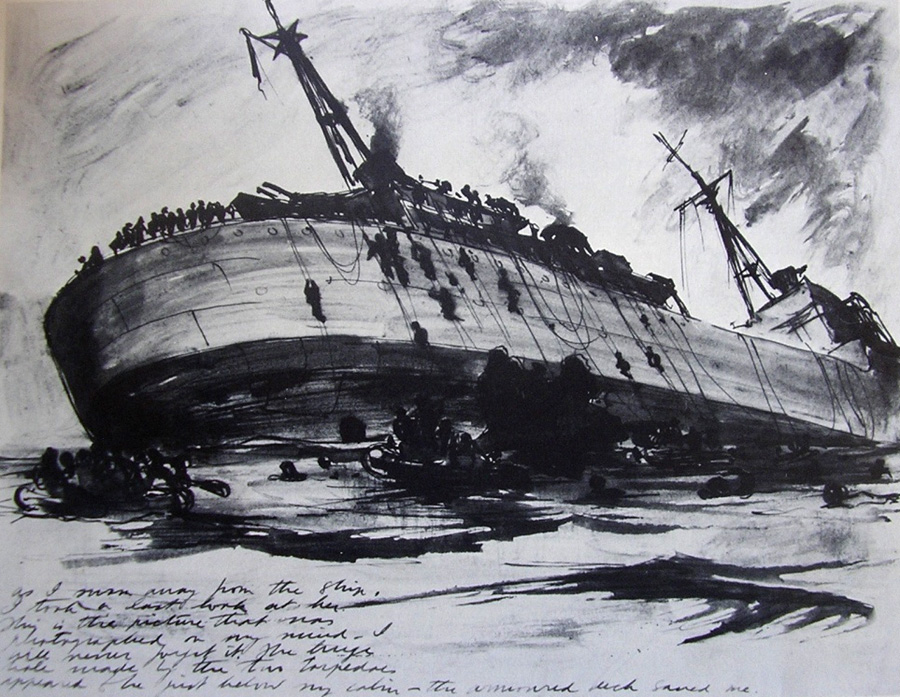
Meanwhile Marne was rolling in the swell, her stern amputated by a torpedo. You could even see her 4.5-inch shell cases in the after magazine being lapped by the sea.
Could Venomous reach Casablanca?
After all the emergencies, Venomous
was desperately short of fuel and the Captain was in a quandary. He had
505 survivors on board. One of our newest destroyers was a floating log
with its propellers removed. Submarines might still be around. We tried
to take fuel from Marne but
the swell prevented this. At about 4 pm we sighted a frigate and a
corvette, and the Captain called them up by light, and ordered one to
take Marne in tow under the
escort of the other. Before they arrived the Captain had to move
Venomous away in the direction of Casablanca, at the most economical
speed on one boiler only, of 11 knots. The least cheerful chap in the
Ward Room was the Chief (Warrant Engineer). He by all the gauges had no
fuel left at all, but yet had to coax 120 miles of steaming to
Casablanca. But this breed of warrant engineers is remarkably
resourceful. When a fuel oil pump fails to suck from a fuel tank, there
is a residue left because the suction end of the pipe is a few inches
off the lowest part of the tank. So Chief got his Chief Stoker to
organise the Stokers to go down through manholes, with face masks to
supply fresh air, and they handed up bucket by bucket all the residues
and poured them all into just one tank. A heroic effort. Fuel oil is
like filthy treacle and the fumes are dangerous. [Warrant Engineer Horace Rance Pead RN was MID for his efforts that day]
NOTE
From
this point onwards Tony Sangster's memory of events is less reliable.
The survivors who died from their wounds after rescue were buried at
sea after leaving Casablanca while en route to Gibraltar. Lt Cdr "Harry"
Alexander RN, the most senior survivor to be rescued by Venomous, was
photographed reading the prayers at the burial. On arrival at
Casablanca Venomous berthed alongside USS Augusta and it was here that
the survivors were kitted out with US Navy clothing and given a hot
meal before rejoining Venomous
which later moored alongside a USN flattop where the survivors spent
the night sleeping in the aircraft hangers. Tony Sangster gives its
name as USS Boxer but it is thought that he was mistaken and it was
actually USS Chenango. These errors have not been corrected.
Meanwhile we had to bury three dead at sea, wounded survivors who had
not recovered. The prayers for such burials are in your prayer book.
Nest morning we entered the erstwhile Vichy France controlled harbour
of Casablanca. We berthed ourselves at a jetty opposite the Escort
Carrier USS Boxer. Except for the usual piped salute of the ‘still’ from both of us there was really at first no acknowledgment from Boxer of our survivors. Then an officer arrived to say “Please send your survivors over 20 at a time, every 20 minutes.” Boxer’s
Commander had organised a line of goodies on the scale of one minute
per man. Issue of new jean sailor’s kit, shaver, thank you very much,
and off you go back. I went over to witness it, and it really seemed
like a Henry Ford production line, but much more humorous on both sides
of the counter.
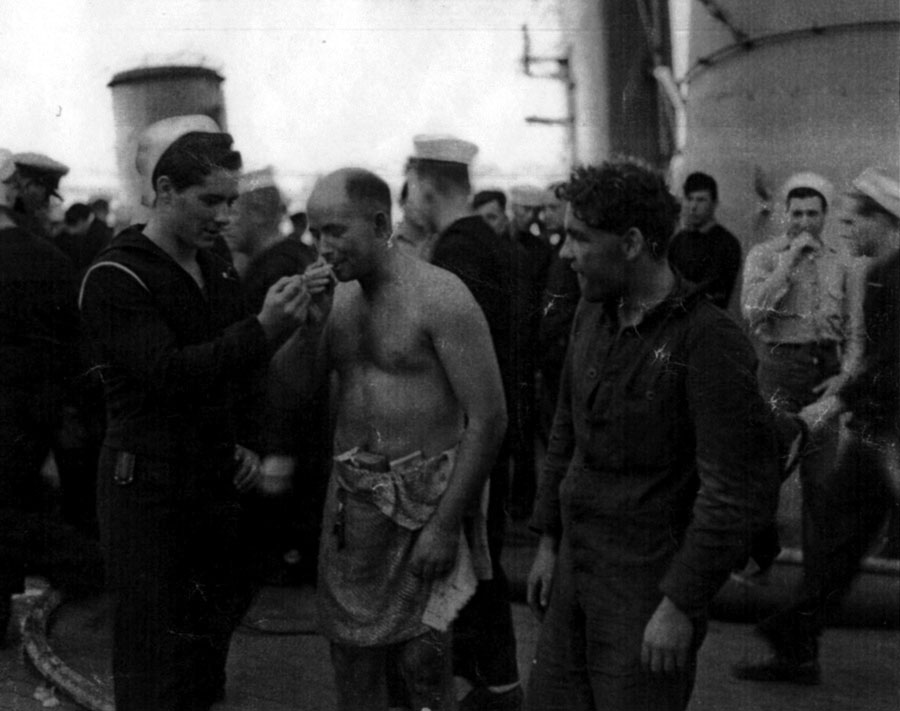
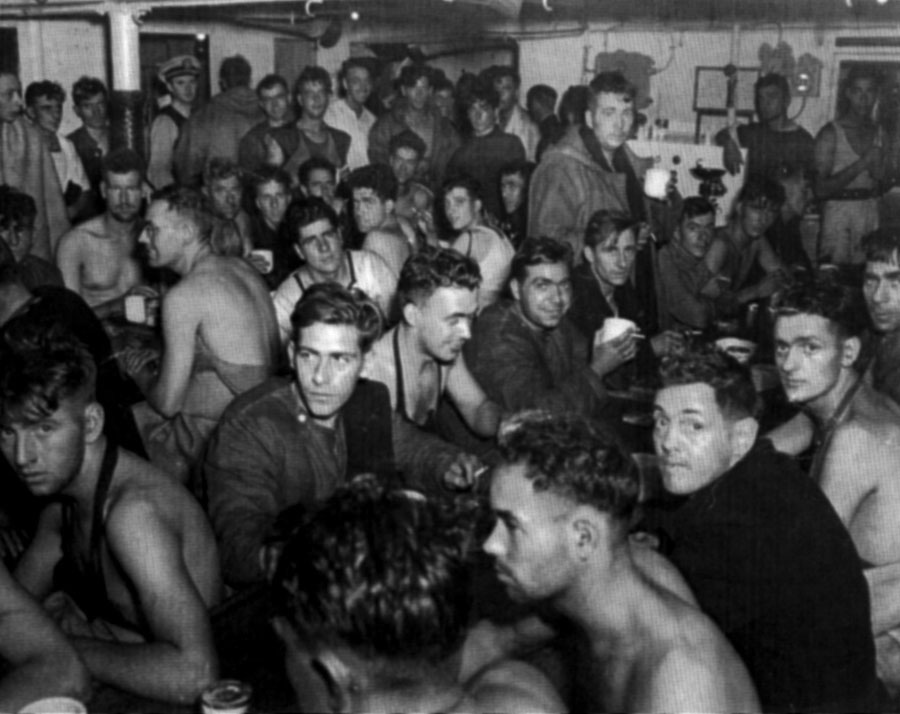
Having fuelled from Boxer, I think, Venomous made her way back to Gib., and said goodbye to our passengers. I wonder how many of those will read this little story.
What I never mentioned was that Vindictive
pressed on with her 24 knots and reached Algiers unescorted. Sadly I
gather that her Captain got a very cold reception from one Admiral, who
considered he had fled from the centre of action.
Aftermath
Herbert James Brown Button did
not live. After his rescue efforts he was exhausted and stayed in the
bunk next to mine. After several hours he started groaning and seemed
to be in a coma so I got our Surgeon, Lt Maxwell to examine him.
We put into Algiers and he was lowered in a special stretcher and then
taken ashore and by ambulance to hospital, and death by meningitis; a
great sadness to us all, and certainly not the way to end a story.
I never knew whether our depth charges had sunk the U-boat, but it
often struck me as strange that the U-boat did not attack the
stationary Marne the next day.
In 1980 I got this information from the Ministry of Defence, Naval Historical Branch.
Being Correspondence Officer I helped to draft and finally typed the
Captain’s report and we certainly did not claim even a ‘possible’ kill.
*******
Midshipman Stephen Barney joined Venomous soon after Hecla sank and had a great liking for Tony Sangster, his "oppo".
He took over from him as Correspondence Officer and recalled that before the
handover Sangster went to immense trouble to see that the ratings were
compensated for the clothes and blankets they had willingly given the
survivors of HMS Hecla.
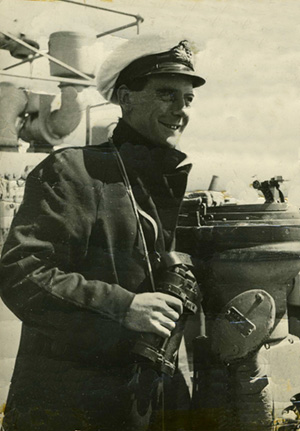 Cdr H.W. Falcon-Steward RN left in December and was succeeded as CO by the flamboyant Cdr
D.H. Maitland-Makgill-Crichton RN but he did not stay long and was
replaced by a very different CO, the modest unassuming Lt Henry D.
Durell RN, who quickly won the affection of his fellow officers.
Stephen Barney recalled one characteristic incident when Tony Sangster
shaved off his beard and entered the Wardroom pretending to be an
officer from another ship. Durell went along with the legpull, made the
visiting officer welcome and offered him a drink. Tony Sangster
described Durell as "a man of great charm, great professional
competence, and an uproarious sense of humour which made him a great
debunker of the ridiculous" and told an amusing story
which illustrated these characteristics in his memoir.
Cdr H.W. Falcon-Steward RN left in December and was succeeded as CO by the flamboyant Cdr
D.H. Maitland-Makgill-Crichton RN but he did not stay long and was
replaced by a very different CO, the modest unassuming Lt Henry D.
Durell RN, who quickly won the affection of his fellow officers.
Stephen Barney recalled one characteristic incident when Tony Sangster
shaved off his beard and entered the Wardroom pretending to be an
officer from another ship. Durell went along with the legpull, made the
visiting officer welcome and offered him a drink. Tony Sangster
described Durell as "a man of great charm, great professional
competence, and an uproarious sense of humour which made him a great
debunker of the ridiculous" and told an amusing story
which illustrated these characteristics in his memoir.
Tony
Sangster's memoir continues with a description of a curious incident of
"spontaneous combustion" off Cape Bon while escorting the first west to
east convoy from Gib to Alex since 1941 and then the escort of the
"second wave convoy" to the landings near Augusta on the south east
corner of Sicily in July 1943. After the Sicily landings Venomous
returned to the Clyde for an urgent refit and Tony Sangster was
"relieved and sent on leave to await appointment". He traveled to the
USA on the 51,000 ton Cunard liner Aquitania, converted into a troopship, to take command of HMS Loring,
a diesel-electric Captain Class Frigate, while it was under
construction in the Boston Naval Yard. After commissioning he served as
First Lieutenant to Lt J Ogilvy RN.
In November 1944 Tony Sangster was posted to the Hunt Class destroyer, HMS Blackmore, as First Lieutenant while it was under refit at Sheerness before it left for the Far East. In April 1943 HMS Blackmore
arrived at Trincomalee in Ceylon, where he was born and met his future wife, Ellen Mawdsley ("Lell") Paterson, the 27 year old
widow of a fighter pilot killed on patrol over Dunkirk in 1940, a member of the the army nursing corps, the First Aid Nursing Yeomanry (FANY). HMS Blackmore was deployed as a weather ship in the Andaman islands during the landings at Rangoon (Operation Dracula) in May and in preparation for the cancelled landings in Malaya (Operation Zipper).
As a career officer Tony Sangster remained in the Navy after the war ended. He remet and married Lell Paterson on 15 April 1946 while serving as Drafting Officer at FOMAS in Singapore and in August 1948 was lent to the Royal Australian Navy (RAN) and took passage to Australia with his wife on the Stratheden. He served with the RAN for two years, on HMAS Leeuwin (1948-9) and during the Korean War as Lt Cdr A.d'E. T. Sangster RN on HMAS Shoalhaven (1949-50) based in Japan. He returned to Britain in December 1950 and retired from the Royal Navy in 1956 when he was 35
Their
two sons, Michael and Charles Sangster, were born in Britain and Tony
Sangster started a new career at John Summers steel works on Deeside and the family lived in Tarporley, Cheshire. He remained with John Summers until his retirement and died in March
1992. His widow died peacefully in the family home in February 2001 aged 103.

Officers serving on on HMS Venomous
on the 12 November 1942
A complete list of the officers and men serving on HMS Venomous during this action can be seen by clicking on the link
The
list has been compiled by TNT Data Services under contract to the
Ministry of Defence based on the seventy year old hand written
Pay and Victualing Ledgers kept by the Admiralty.
Read Lt Cdr H.C.R.Alexander' RN's "View from the Bridge" of HMS Hecla